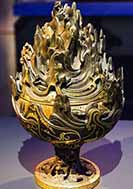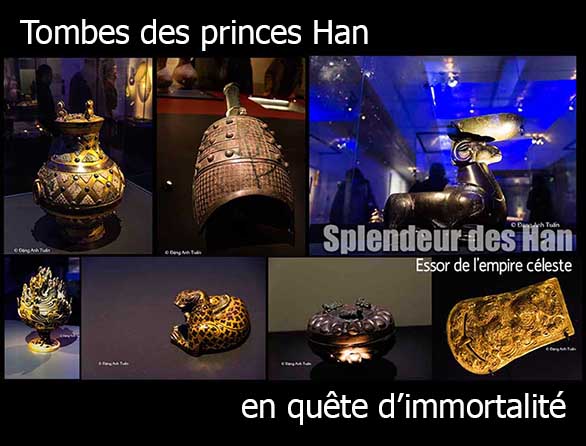Vietnamese version
French version
Similar to their predecessor Qin Shi Huang Di, the emperors of the Han dynasty sent emissaries during their reign in search of paradisiacal places with the aim of seeking immortality and accessing the divine world. These mythical lands are often associated with Penglai Island (đảo Bồng Lai) located to the east and Mount Kunlun (Côn Lôn) to the west in the beliefs of the Han era. It is the mountain where the Queen Mother of the West (Tây Vương Mẫu) (Xiwangmu) resides, who possessed the elixir of immortality. This is why her presence is recurrently found in the decoration of Han tombs. This testifies not only to her popularity but also to the Taoist conception related to the prolongation of life beyond death. According to some unverified and unjustified rumors, Zhang Qian was initially tasked by Wudi to search for immortality recipes near Mount Kunlun, the western abode of the immortals. Always dressed in a long tunic, they have an elongated and angular face, a wide mouth above a pointed chin, arched eyebrows, and large ears, which gives them a rather strange silhouette and an emaciated appearance. Once the dao is reached, they have wings on their shoulders. In the Taoist conception of the afterlife, to preserve the physical integrity of the deceased and the immortality of their soul, the nine orifices of their body must be sealed with gold and jade pieces (mouth, ears, eyes, nostrils, urethra, rectum).
Then the deceased must be made to wear a mask or a jade suit whose use is governed by a very strict hierarchical protocol. For emperors, the jade suit is sewn with gold threads. As for kings and other less important dignitaries, their jade suit only has threads of silver or copper. The use of the suit reflects the Han belief in the soul’s perpetuity in the afterlife because jade is attributed with apotropaic properties that help promote the soul’s immortality.
During the Han period, the dualistic conception of the soul was mentioned in several Chinese texts such as the Huainanzi by Liu An (Hoài Nam Tử). Each individual has two souls: one called hun that goes to heaven and the other called po that physically disappears with the deceased. To prevent the hun soul from escaping through the facial orifices, the mask or suit proves indispensable.
Is this dualistic conception of the soul truly Chinese or borrowed from another civilization, that of the Baiyue? It is found among the Mường, the cousins of the Vietnamese, living in the most remote corners of the mountainous regions of Vietnam. For the Mường, there are several souls in a human being which they call wại. These are divided into two categories: wại kang (the splendid souls) and wại thặng (the hard souls). The former are superior and immortal while the latter, attached to the body, are evil. Death is only the consequence of the escape of these souls.
It is important to recall that the culture of the kingdom of Chu (Sỡ Quốc), conquered by Qin Shi Huang Di during the unification of China, had a particular originality, its own language, that of the Bai Yue. From the Qin-Han period onwards, there existed an imperial institution, the fangshi, who were local scholars considered magicians specialized in star rites and government recipes.
Their role was to collect, each in their own territory, ritual procedures, beliefs, local medicines, systems of representation, cosmologies, myths, legends, as well as local products, and submit them to the political authority so that it could decide whether to retain them or not and incorporate them in the form of regulations with the aim of increasing imperial power in an ethnologically very diverse nation and providing the emperor with the means for his divine vocation. Everything had to be collected and added to the service of the Son of Heaven in order to establish his legitimacy over recently conquered barbarian territories.
___This is one of the characteristic traits of Chinese culture: It knows how to accept and absorb foreign cultures without ever showing signs of wavering or cultural modifications.___
This is what the famous 20th-century Chinese philosopher Liang Shuming wrote in the introduction to his work entitled « The Main Ideas of Chinese Culture » (translation by Michel Masson). This echoes the following remark made by the French ethnologist and sinologist Brigitte Baptandier in her conference text during an APRAS study day on regional ethnologies in Paris in 1993:
Chinese culture thus formed over the centuries as a kind of mosaic of cultures. It requires a slow infusion of barbarian blood into China, adapting this beautiful phrase of the historian F. Braudel for France with the barbarians.

The Boshanlu incense burners (incense burners shaped like Mount Bo) were meant to represent the mythical mountains bathed in clouds and qi vapors (vital cosmic energy). The popularity of these incense burners was largely due to Han thought on immortality and the cult of sacred mountains.
Boshanlu
According to the estimate of the dean of Chinese archaeologists Wang Zhongsu, since 1949 more than 10,000 tombs have been excavated from the Han dynasty alone. Thanks to major archaeological discoveries from the tombs of Lady Dai and her son at Mawangdui (Changsha, Hunan) (168 BC), or the tomb of Emperor Jindi’s son, Prince Han Liu Sheng and his wife Dou Wan (Mancheng, Hebei) (113 BC), as well as the tomb of Zhao Mo, grandson of Zhao Tuo and king of Nanyue (Xianggang, Guangzhou) (120 BC), archaeologists have begun to better understand Han art through thousands of exceptional objects made of jade, iron, and bronze, ceramics, lacquerware, etc. These testify to the opulence and power of the princely courts under the Han. They are sometimes unique specimens revealing not only exquisite technical craftsmanship and the preciousness of the materials but also regional particularities.
During the excavations, archaeologists observed that there is a break in Chinese art, a profound change historically corresponding to the development of the unified empires (Qin and Han) and contact with foreign influences. The presence of secular objects, particularly bronze vessels commonly found during the Zhou period, gave way to the development of figurative art and pictorial representations. There is undoubtedly a notable influence from other cultural spheres in the field of Han art, especially in material culture. From then on, ancestor worship no longer took place in temples as it had during the Bronze Age but occurred within the tombs and in sanctuaries near them. Moreover, like Emperor Qin Shi Huang Di, the Han emperors and their princes tended to make the tomb a replica of their earthly royal residence.
This concept dates back to the Zhou period and was frequently illustrated in the funerary practices of the elites of the Chu kingdom. Similar to the latter, the Han believed in the soul’s continuity in the afterlife. The vision of death was considered a continuation of life. This belief remains alive today in China during the Qingming Festival, with sacrifices offered to ancestors: fake money and funerary objects burned.
It is for this reason that during excavations, everything they owned in their lifetime is found: favorite objects, terracotta figurines representing their household staff, as well as jade shrouds intended to reduce death to nothingness. The imperial tombs of the Han are marked by the presence of a high artificial mound located within a rectangular enclosure where the burials and ancillary pits are also found. The structure of their tombs becomes increasingly complex and often rivals that of their palaces, with separate pits each having a distinct function (storehouse, stable, kitchen, banquet hall, etc.). This is the case of the Liu Qi site, known as Emperor Jindi, and his wife, Empress Wang, in the suburb of Xi’an. It is in these pits that luxury items (vases, basins, incense burners, mirrors, weights for mats, cauldrons, lamps, daggers, etc.) or everyday items (grains, fabrics, meat, etc.) of the deceased are found, leaving archaeologists dumbfounded and silent with admiration, alongside terracotta figurines (or mingqi). These can be either figurines of domestic animals or human statuettes.
Thanks to the Silk Road and Chinese expansion, a large number of regional artistic traditions, foreign fashions, and new products contributed to the artistic flourishing of the Han. Cosmopolitanism certainly played an important role at that time.
The splendor of luxury objects found in tombs reveals not only the grandeur and refinement of princely courts but also a taste for exoticism. The dances and music of Chu, the songs of Dian, and the art of Central Asian minstrels renew the court’s entertainment. Contacts with the arts of the steppe promote the enrichment of the decorative repertoire.
Similar to jade, bronze was one of the materials highly prized by the Chinese. During the Han period, the popularity of bronze began to decline because for ancestor worship, there was no longer a need for complete sets of ritual bronze vessels, and lacquer objects imitating those of the kingdom of Chu were preferred instead. The latter had frequently decorated them with motifs or figures of great imagination according to its own mythology during the Warring States period.
Despite the visible decline in the tombs of Han princes, bronze was still widely used in chariot ornaments and luxury objects found
[Reading Art of living]

